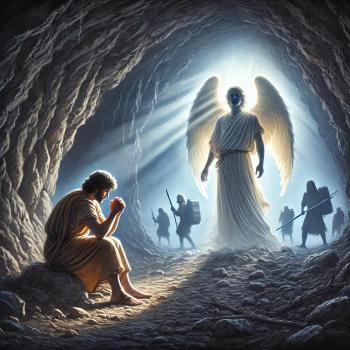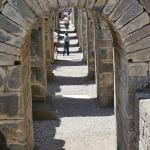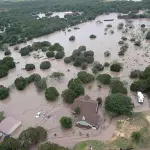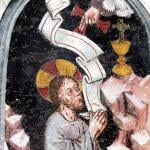Revelation 7:1-17 Prepared for Protection
We have seen God reveal to John the Risen and returning Messiah ready to come and take possession and power over the Earth. We have seen Jesus speak to the churches about the present persecution and to be prepared for His return. We have seen the first set of six seals which open up the events on Earth to be ready for the judgment of God. Now we come to a pause.
In many adventure films, there is a pause where the hero and his/her band of followers stop to assess the threat that will soon appear and to prepare themselves for the difficult journey ahead. The Mos Eisley Cantina in Star Wars, the Elvish home of Rivendell in Lord of the Rings, the build-up of Operation Desert Shield before it turned into Operation Desert Storm in the 1991 Gulf War. They all represent times of preparation before the inevitable fight that will take place.
Some theologians makes the case that this sealing does not happen after the horseman vision earlier in the chapter. Instead, they claim that this measure of protection is given before the first four seals. They claim that: God’s control over the horsemen/winds ensures that his church is sealed and secure before they ride forth.1 There might be some truth to that. Yet, the point of this pause is for the people of God to be prepared for protection to be ready to overcome what they may soon encounter.
As Chuck Missler notes, “six of a group of seven things will be presented, and then there is a pause with a change of subject, or a parenthetical discussion of some kind, and then the seventh thing is presented. In this case, we have six seals, and then 144,000 Israelites are sealed in chapter seven. Chapter eight then opens with the seventh seal.”2
Preparation for Protection (Revelation 7:1-3)
Five angels are involved in this call for a time of preparation for protection. Four angels hold back natural events, and in doing so postpone the events of the rest of Revelation. The point of this postponement is to get God’s people ready.
Many parenthetical interludes in Revelation (e.g., 14:1–5; 15:2–4; 20:4–6), especially hymns (12:10; 19:1–8), also concern the protection or salvation of the righteous, placing the judgment scenes in an encouraging context. Judgment serves a redemptive purpose, not only to invite repentance from the disobedient (9:20–21) but to vindicate the righteous oppressed (6:10).3
The sealing described in Revelation 7 certainly has its background in Ezekiel 9:1–7, where the faithful were sealed before God’s judgment fell.4 While some people think that these people are protected from physical harm from the Antichrist, it is more likely that these groups are protected from God’s judgment. There are two main views about who these two groups are.
TWO VIEWS OF THE 144,000 AND THE MULTITUDE
1. The first view is that they are the same people.
The interlude of chapter 7 consists of two visions: the protective sealing of the 144,000 on earth (7:1–8) and the celebration of the great multitude in heaven (7:9–17). These two visions likely depict the same group of people, the people of God, but do so from two different perspectives. First, we see the people of God on earth arrayed in battle formation and protected from divine judgments to come. Second, we see the people of God in heaven, celebrating God’s faithfulness in sustaining their victorious endurance.5
John hears about a conquering Lion from the tribe of Judah (5:5), but turns to see instead a slaughtered Lamb (5:6); here John “hears” the number of God’s servants (7:4) but “sees” a countless multitude (7:9). As the conquering Lion turns out to be a slaughtered Lamb, the end-time army of Israel turns out to be the host of martyrs from among the nations.6 Our “holy war” is our faithful, nonviolent witness to the death.7
FIVE REASONS WHY THESE TWO GROUPS ARE THE SAME PEOPLE
1. The number itself results from multiplying the square of 12 by 1000, emphasizing the people of God in its totality and fullness.
2. While some see the 144,000 as referring to literal Israel or a Jewish remnant (perhaps suggested by the phrase “from all the tribes of Israel”), it is more likely that the group represents the true people of God or the whole company of the redeemed.
3. What’s more, the list of tribes in verses 5–8 even hints at a symbolic interpretation. The Old Testament lists themselves do not agree with one another, and by John’s time most of the tribes were unidentifiable.
4. We also notice that Judah heads the list because this is the tribe to which Jesus belonged. The tribe of Dan is missing, likely due to its association with idolatry and apostasy, as is Ephraim, perhaps due to its opposition to Judah. Levi is included, maybe because the people of God are portrayed in Revelation as priests.
5. Finally, the term “tribe” (phulē) is used throughout Revelation in a universal sense (Revelation 1:7; 5:9; 14:6; 21:12).8
So this interpretation sees the 144,000 as symbolic of Christianity in the time of the tribulation. Which makes sense because since the church will be raptured, with this group of 144,000 everyone who believes, not matter where they come from will be “saints.” These evangelists lead the second group to salvation in Jesus Christ.
2. These two groups are completely different.
This is the traditional evangelical view. This is the view to which I subscribe. As Warren Wiersbe notes:
While we are not told explicitly in Scripture that the 144,000 Jews are God’s special witnesses, and that the Gentile host is saved through their ministry, this appears to be a logical deduction; otherwise, why are they associated in this chapter? The parallel with Matthew 24:14 also indicates that the 144,000 will witness for the Lord during the Tribulation.9
Paige Patterson notes that if God numbers the very hairs of our heads, then it follows that he is able to know the genealogical descent of individuals whether a record has been kept or lost. Consequently, it is not farfetched to imagine that 12,000 from each of these 12 tribes of Israel will be sealed and saved. The issue is not so much a question of the identity of the 144,000 as to whether the Jewish people remain a significant part of the plan of God in the eschaton.10
Group #1: The Army of Evangelists (Revelation 7:4-8)
Here we have the 144,000 listed in Revelation. Who are they? They are Jews from twelve different tribes. But you will notice that not all tribes are listed. This occasionally happens in Scripture.
Warren Wiersbe asks: “Why is Levi included when it had no inheritance with the other tribes? (Numbers 18:20–24; Joshua 13:14) Why is Joseph named but not his son Ephraim, who is usually connected with his brother Manasseh? Finally, why is the tribe of Dan omitted here and yet included in Ezekiel’s list for the apportionment of the land? (Ezekiel 48:1)”11
The English scholar the Venerable Bede believed that the tribe of Dan was omitted for an interesting reason. “With good reason, he begins with Judah, from which tribe our Lord sprang; and has omitted Dan, from whom, as it is said, Antichrist is to be born; for it is written”12
“Dan shall be a serpent in the way, a viper by the path, that bites the horse’s heels so that his rider falls backward.” (Genesis 49:17, ESV)
Arnold Fruchtenbaum notes that even Simeon is not listed in Deuteronomy 33.13 Richard Bauckham argues persuasively that the numbering of Revelation 7:4–8 suggests that those numbered are an army who are to conduct ironic holy war.14
TWO TRUTHS FROM THIS SECTION
Two truths become clear from this passage, even if we don’t know all of the details:
1. God provides for His Jewish children to serve Him.
Just as God returned the Jews to their homeland, He is going to allow them to be identified as Jews again. Right now, we don’t know which tribe a Jew comes from. By the time of the Tribulation of Israel, the Jews will be able to identify from which tribe they came. This sealing of protection is in opposition to the mark that the Antichrist will place on people who will identify with him.
2. God uses His Jewish children to share the Gospel.
The Jews, who once rejected the Gospel, will now share the Gospel. As the church has left the scene, God will use Messianic Jews to share the Gospel with the entire world. Those newly formed saints will encounter similar persecution. However, they will not be protected. They will be slaughtered.
Group #2: The Persecuted Saints (Revelation 7:9-17)
These persecuted saints are the “tribulation saints” or the church remnant that exists after the rapture.
God’s people are protected from God’s wrath but not from the wrath of the beast and his followers. This explains why they can be sealed and simultaneously some suffer martyrdom. We will never experience the wrath or condemning judgment of God (Romans 8:1), but we may experience opposition, persecution, and even death at the hands of evil forces.15
The best and most long-lasting motivational influence comes from the assurance that the Lord of my daily walk of faith today is the same Lord I shall meet at the end of my journey. The song is the song of relationship; the future hope is portrayed in relationship language. It is not a stranger who stands at the boundary of all human history but the same Lord Jesus Christ who stood at Galilee and Jordan and at the harsh hill near Jerusalem. This makes all the difference.16
May the experience of the church remnant in this chapter inspire our church today.
1 Michael Wilcock, The Message of Revelation: I Saw Heaven Opened, The Bible Speaks Today (Leicester, England; Downers Grove, IL: InterVarsity Press, 1986), 79.
2 Chuck Missler, Learn the Bible in 24 Hours® (Nashville: Thomas Nelson, 2002).
3 Craig S. Keener, Revelation, The NIV Application Commentary (Grand Rapids, MI: Zondervan Publishing House, 1999), 230.
4 Warren W. Wiersbe, The Bible Exposition Commentary, vol. 2 (Wheaton, IL: Victor Books, 1996), 590.
5 J. Scott Duvall, Revelation, ed. Mark L. Strauss and John H. Walton, Teach the Text Commentary Series (Grand Rapids, MI: Baker Books, 2014), 112.
68 Bauckham, Climax of Prophecy, 215–16; Michaels, Revelation, 113.
7 Craig S. Keener, Revelation, The NIV Application Commentary (Grand Rapids, MI: Zondervan Publishing House, 1999), 232–233.
8 J. Scott Duvall, Revelation, ed. Mark L. Strauss and John H. Walton, Teach the Text Commentary Series (Grand Rapids, MI: Baker Books, 2014), 114–115.
9 Warren W. Wiersbe, The Bible Exposition Commentary, vol. 2 (Wheaton, IL: Victor Books, 1996), 590.
10 Paige Patterson, Revelation, ed. E. Ray Clendenen, vol. 39, The New American Commentary (Nashville, TN: B&H, 2012), 196.
11 Warren W. Wiersbe, The Bible Exposition Commentary, vol. 2 (Wheaton, IL: Victor Books, 1996), 590.
12 Venerable Bede, The Explanation of the Apocalypse, trans. Edward Marshall (Oxford: James Parker and Co., 1878), 46.
13 Arnold G. Fruchtenbaum, Israelology: The Missing Link in Systematic Theology, Rev. ed. (Tustin, CA: Ariel Ministries, 1994), 301.
14 Bauckham, Climax of Prophecy, pp. 217–29; so also in less developed form by J. Valentine, ‘Theological Aspects of the Temple Motif in the Old Testament and Revelation’ (Unpublished PhD dissertation; Boston, MA: Boston University Graduate School, 1985), pp. 219–23.
15 J. Scott Duvall, Revelation, ed. Mark L. Strauss and John H. Walton, Teach the Text Commentary Series (Grand Rapids, MI: Baker Books, 2014), 112.
16 Earl F. Palmer and Lloyd J. Ogilvie, 1, 2 & 3 John / Revelation, vol. 35, The Preacher’s Commentary Series (Nashville, TN: Thomas Nelson Inc, 1982), 177.












